Writing: Yinan
Project Introduction
Introduction:
Espresso Systems initially aimed to build a highly scalable, privacy-focused decentralized L1 protocol, but later found that it did not require as much L1, so it will be achieved by building for the Ethereum ecosystem. To achieve this vision, two separate efforts were made to address privacy and performance issues.
To provide better privacy options, Espresso developed the CAPE application, which is Espresso's smart contract system that can achieve transaction-level privacy with custom configurations. CAPE can be deployed on any EVM chain.
The sequencer is responsible for verifying and batching transactions on the second layer blockchain, and then sending them back to the first layer chain (such as Ethereum) for settlement. Rollups actually do not require sequencers; this is just a design choice aimed at providing users with a better experience in terms of lower fees and faster transaction confirmation.
The main issue with sequencers at present is that they often tend to be prone to centralization (often operated by a single operator in many cases) and carry risks such as transaction censorship, MEV extraction, and creating single points of failure (i.e., validity issues).
Solutions such as Espresso's shared sequencer (relying on separate, permissionless network nodes) are aimed at helping to address this issue. Espresso is creating a market for shared sequencing, through which the second layer chain will sell block space to shared proposers, including proposers from the Ethereum mainnet EVM itself, who create additional value by satisfying the intentions of users on multiple chains.
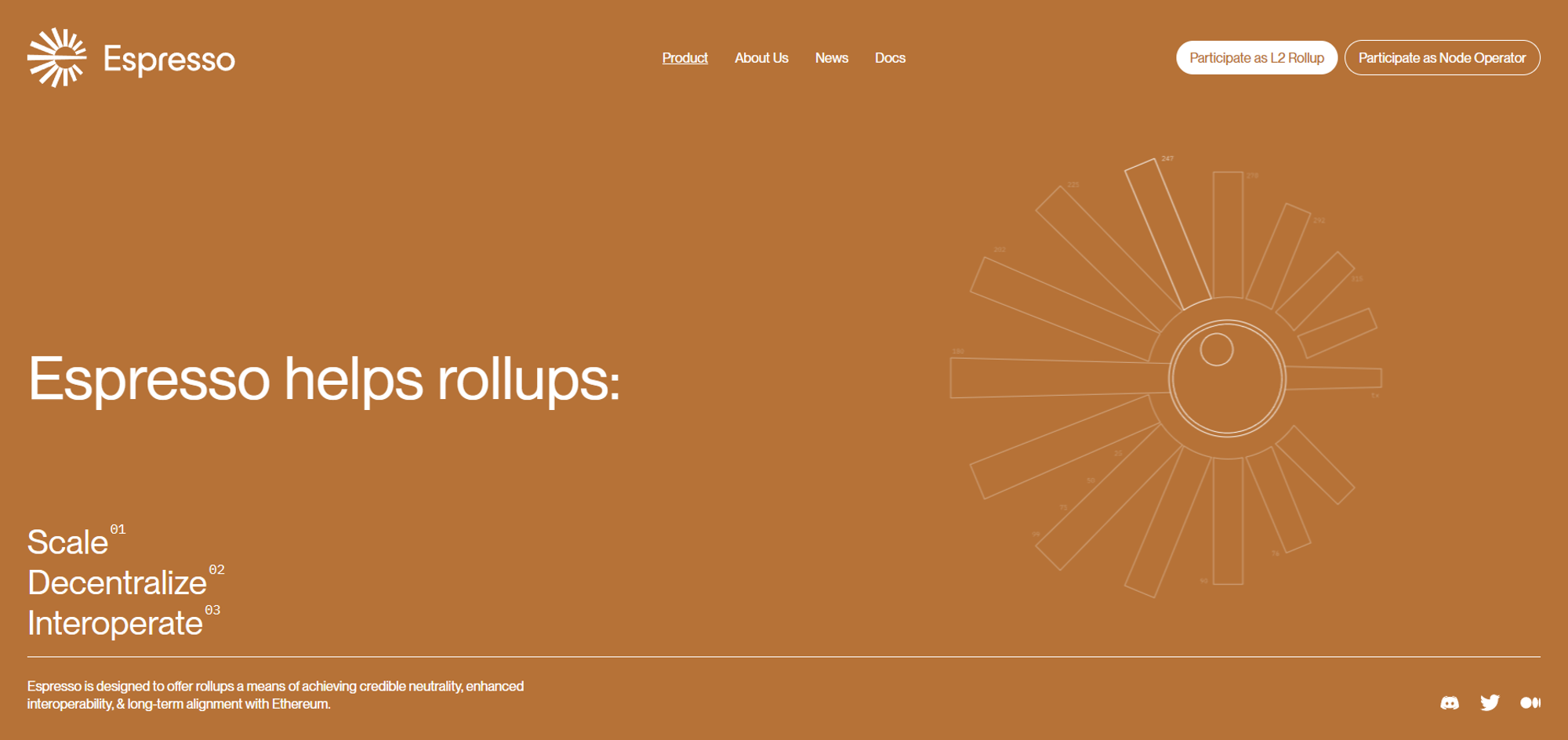
Technical Architecture
CAPE
CAPE is the implementation of Espresso Systems' configurable asset privacy protocol on Ethereum. Configurable asset privacy is a protocol that allows asset creators to issue private digital assets while specifying parties that can view designated data about ownership and transactions. CAPE also supports more advanced strategies using private verifiable credentials, frozen keys, or threshold schemes.
VERI-ZEXE —- Decentralized Private Computation (DPC) System
In 2019, Bowe et al. proposed a scheme called Decentralized Private Computation (DPC), which allows users to execute arbitrary computations off-chain and submit transactions using zero-knowledge proofs to prove the correctness of the computation. They implemented a system called ZEXE (zk-execution), which instantiates the DPC scheme to address the above two pain points. Roughly speaking, ZEXE is a "programmable Zcash," extending from a single application system to a smart contract system while maintaining privacy guarantees.
VERI-ZEXE significantly improves transaction generation by approximately 9.0 times and memory usage by approximately 2.6 times, and will be used in future versions of CAPE to enable arbitrarily user-defined asset policies while maintaining configurable asset privacy.
HotShot
HotShot is a consensus protocol that prioritizes high throughput and fast finality, based on the HotStuff protocol.
HotShot is open and permissionless, and it decentralizes the power of participation in the sequencer network, providing high throughput and fast finality while ensuring security and effectiveness. HotShot adopts a proof-of-stake (PoS) security model, and one of the key requirements proposed by the Espresso team is to achieve strong performance without affecting the scale of the validator set. Specifically, HotShot should be able to scale to include all Ethereum validators (currently over 700,000) participating.
Tiramisu
Tiramisu is a data availability solution with three novel layers; most rollups rely on L1 blockchains (such as Ethereum) to provide data, but the drawback is that it is very expensive.
- The base layer of Tiramisu is called Savoiardi. This is an anti-bribery layer (similar to Ethereum's danksharding proposal) that provides the highest level of security. However, due to this feature, it is the least user-friendly layer among the three. To address this issue, Espresso added two layers to its solution.
- Mascarpone is the middle layer, ensuring efficient data recovery by electing a small data management committee.
- Cocoa is aptly named the "top layer sprinkling" of the entire system. Cocoa helps Tiramisu provide "Web2-level performance" by providing a content delivery network for Tiramisu. This helps with efficient data recovery and significantly speeds up data propagation. Given that this layer is essentially centralized, it is entirely optional, and Tiramisu can function perfectly without it. It helps to accelerate data availability and can be easily modified or removed.
Espresso Systems considered flexibility and modularity when designing its protocol, and rollup devices using its sequencer can also use any other data availability solution if they do not want to use Tiramisu.
EspressoSequencer
It is a decentralized transaction sequencing system for L2 expansion solutions on Ethereum, a decentralized shared sequencing layer.
Espresso Sequencer is designed around a single decentralized proof-of-stake security model that supports consensus protocols for sequencing transactions and data availability mechanisms that can achieve further performance advantages. It also includes an aggregation contract system that registers submitted transaction blocks, verifies their consistency with consensus protocols and availability certificates, registers updated state commitments for each zk-VM deployed to Espresso Sequencer, and receives and verifies evidence of state updates.
Espresso Sequencer supports decentralized L2. It handles decentralized sequencing and data availability of aggregated transactions, acting as middleware between the aggregator and its underlying L1 platform. Espresso Sequencer is designed as a platform that can deploy any zk-VM or optimistic VM. Ultimately, Espresso can also act as an interoperability layer by replicating zk-VM and optimistic VM to multiple L1s simultaneously.
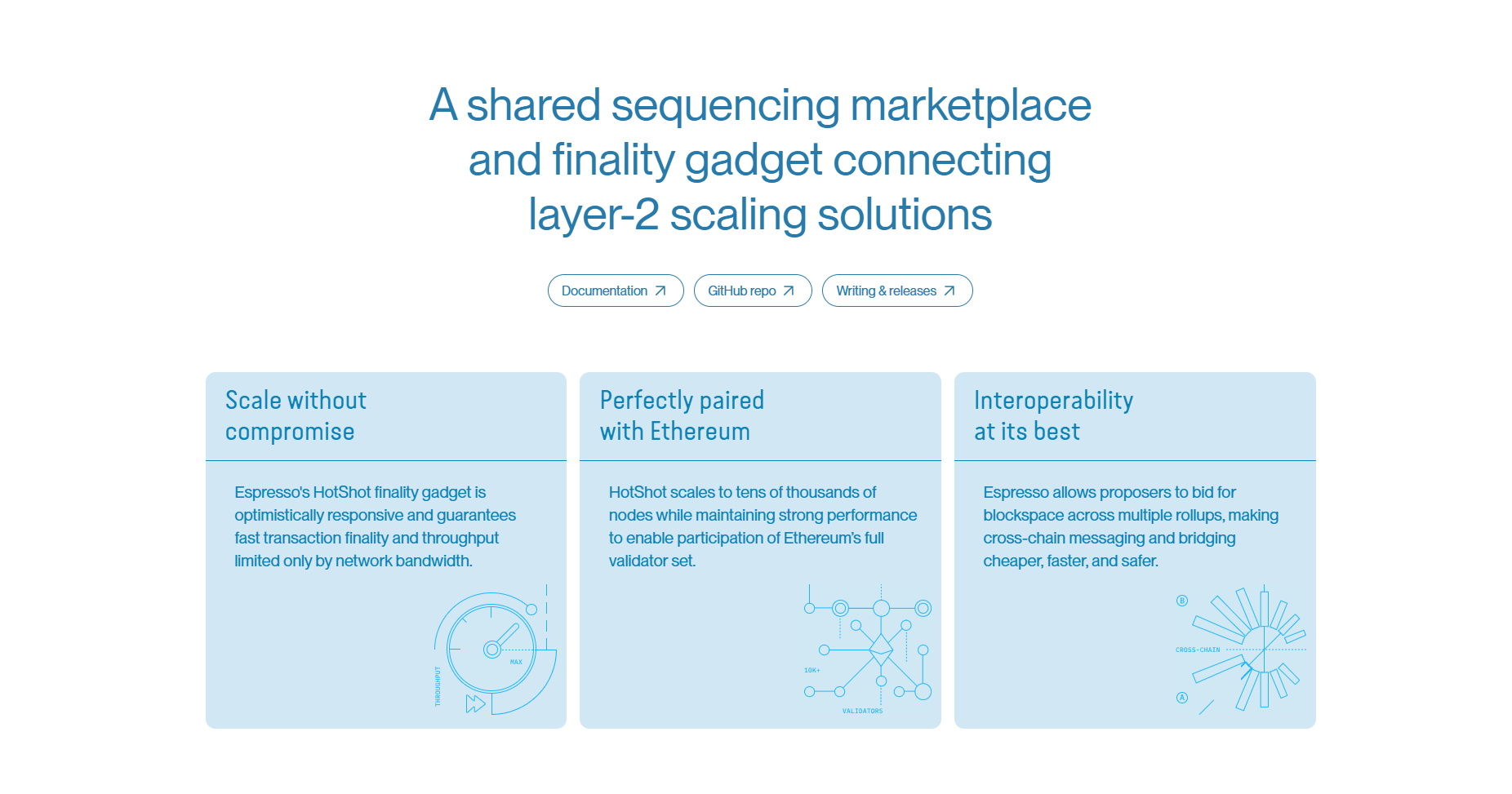
Development Progress
2022/06/15 —- Espresso begins using CAPE on the Goerli testnet
2022/11/28 —- Espresso releases Espresso Testnet 1---Americano, publicly releasing Espresso Sequencer for the first time
2023/07/20 —- Espresso Systems and Polygon zkEVM launch the shared Doppio testnet
2023/08/05 —- Espresso opens the Doppio testnet to the public, and releases a demonstration of end-to-end integration of Espresso Sequencer and Polygon zkEVM stack
2023/09/29 —- Espresso Systems releases Testnet 3---Cortado, seamlessly integrating OP Stack aggregation and Polygon zkEVM aggregation to achieve decentralized, shared sequencing.
2024/01/26 —- Espresso Systems releases Testnet 4---Gibraltar, demonstrating integration with the Arbitrum technology stack. It is also the first time external operators are seen running Espresso Sequencer nodes.
(This testnet version also sees Espresso Sequencer supporting four aggregation stacks (Arbitrum, Cartesi, Optimism, and Polygon zkEVM) and multiple collaborations with Rollup projects.)
2024/02/03 —- Espresso is set to launch the fifth testnet—Cappuccino, and will recruit more entities to run Espresso Sequencer nodes to further decentralize the sequencer. The launch is planned for the end of the first quarter of 2024.
2024/03/13 —- Espresso is creating a shared sequencing market, through which the second layer chain will sell block space to shared proposers, including proposers from the Ethereum mainnet EVM itself, who create additional value by satisfying the intentions of users on multiple chains.
2024/05/22 —- Espresso releases Testnet 5---Cappuccino, and Espresso has extended HotShot's final layer to 100 nodes on the Cappuccino testnet. The testnet also adds support for Arbitrum fraud proofs.
Ecosystem
Project Collaborations
2023/07/19 —- Espresso Systems and EigenLayer announce an ecosystem partnership, leveraging re-delegation on the Espresso Sequencer network. Through EigenLayer, Espresso Sequencer will be able to access Ethereum's staking capital base and decentralized validator set, optimizing node usage and capital efficiency.
2023/07/20 —- Espresso Systems and Injective collaborate, with Injective integrating Espresso Sequencer. This collaboration starts with Cascade, the first cross-chain Solana SVM aggregator in the IBC ecosystem, demonstrating Injective's commitment to long-term decentralization and scalability. Cascade is currently in public testnet, allowing developers to deploy Solana contracts for the first time on Injective and the broader IBC ecosystem.
2023/07/20 —- Espresso Systems and AltLayer introduce Espresso Sequencer into the AltLayer Stack, providing developers with more options for accelerating decentralization through AltLayer's decentralized validation and Espresso Sequencer.
2023/07/20 —- Espresso Systems and Catalyst collaborate to enhance interoperability, with Catalyst becoming the first application dedicated to the Espresso Sequencer ecosystem. Catalyst is a cross-chain AMM platform focused on connecting modular blockchains. Catalyst aims to leverage Espresso Sequencer, laying the foundation for secure, seamless cross-aggregator interoperability. In the coming months, Catalyst plans to prioritize deploying Rollups using Espresso Sequencer.
2023/07/20 —- Espresso Systems announces plans to integrate with Spire, a Layer 3 aggregation-as-a-service product, publicly announcing plans to use Espresso Sequencer for sequencing and data availability.
2023/07/20 —- Espresso Systems launches a testnet with integration with Polygon zkEVM, allowing users to submit transactions to a branch of Polygon zkEVM and then route transactions to nodes running the Espresso HotShot protocol for sequencing.
2023/07/20 —- Espresso Systems and Caldera introduce decentralized sequencing into the OP Stack, deploying optimistic rollup using Espresso Sequencer for ordering and fast confirmation, and using Espresso Data Availability (DA) for storage. Caldera will provide OP Rollup interface, site hosting, block explorer, and indexer.
2023/12/21 —- Espresso Systems and Offchain Labs announce a collaboration to introduce decentralized Timeboost transaction sequencing and Espresso Sequencer into the Arbitrum ecosystem and other areas. Timeboost is a transaction sequencing strategy originally developed by Offchain Labs to protect users from frontrunning and mitigate the harmful effects of maximum extractable value (MEV).
2024/01/26 —- Espresso Systems collaborates with blockchain infrastructure provider Blockdaemon, which will support Espresso Systems by deploying external sequencer nodes. It will manage four sequencing nodes in Europe and Asia.
Current collaborations
2024/03/08 —- Espresso Systems and Across collaborate, allowing Across Protocol to utilize Espresso's fast pre-confirmation feature, secured by the HotShot consensus protocol, which achieves finality after two consecutive blocks. This integration will bridge across Rollups using HotShot's shared security and fast finality.
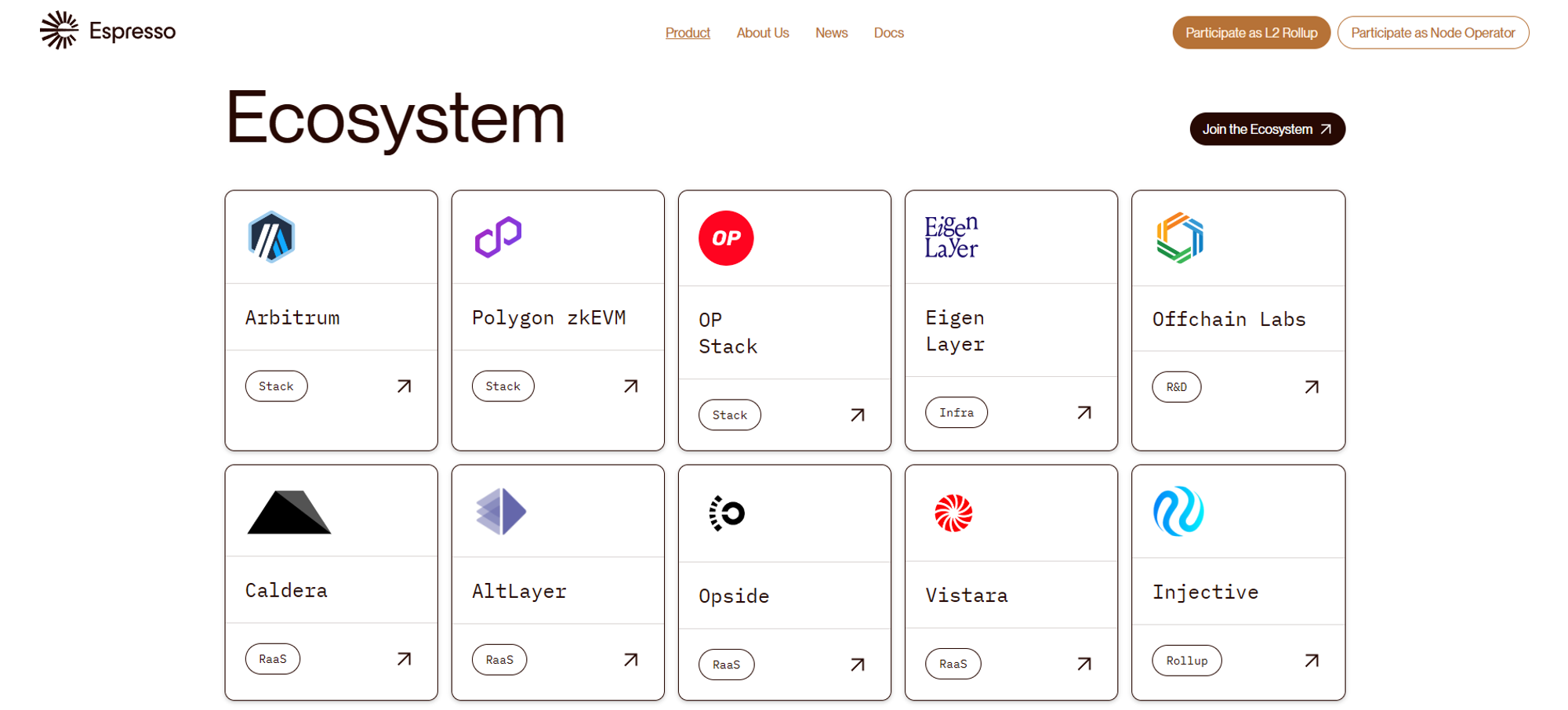
Project Team
Ben Fisch —- CEO and Co-founder of Espresso Systems, is an Assistant Professor of Computer Science at Yale University and previously a Ph.D. student at Stanford University, working with Dan Boneh in the applied cryptography research group.
Charles Lu—- CEO and Co-founder of Espresso Systems. He previously served as the head of Binance Labs at Binance. Charles Lu attended Stanford University.
Benedikt Bünz —- Co-founder and Chief Scientist of Espresso Systems. He is a Ph.D. student in the Dan Boneh applied cryptography group at Stanford University, focusing on cryptocurrency cryptography.
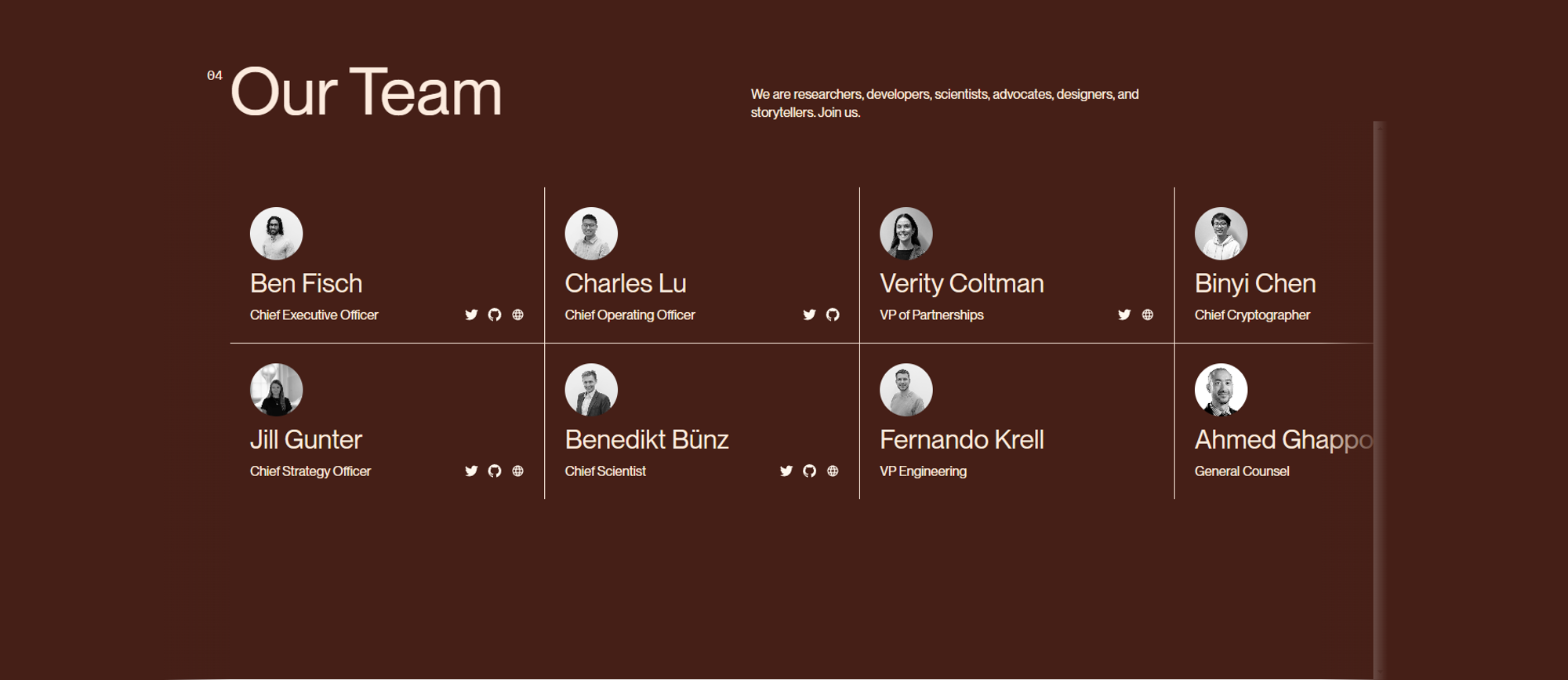
Project Financing
Espresso raised a total of $60 million in seed and Series B financing
On March 6, 2022, Espresso Systems raised $32 million, led by Greylock Partners and Electric Capital, with participation from Sequoia Capital, Blockchain Capital, and Slow Ventures. Espresso Systems also includes major industry participants as supporters, including Polychain Capital, Alameda Research, Coinbase Ventures, Gemini Frontier Fund, Paxos, and Terraform Labs.
On March 21, 2024, Espresso Systems announced the completion of a $28 million Series B financing led by A16zcrypto. Espresso noted that Polygon, Taiko, o1Labs, StarkWare, Offchain Labs, and strategic investors from over 30 ecosystem projects joined their recent Series B financing.
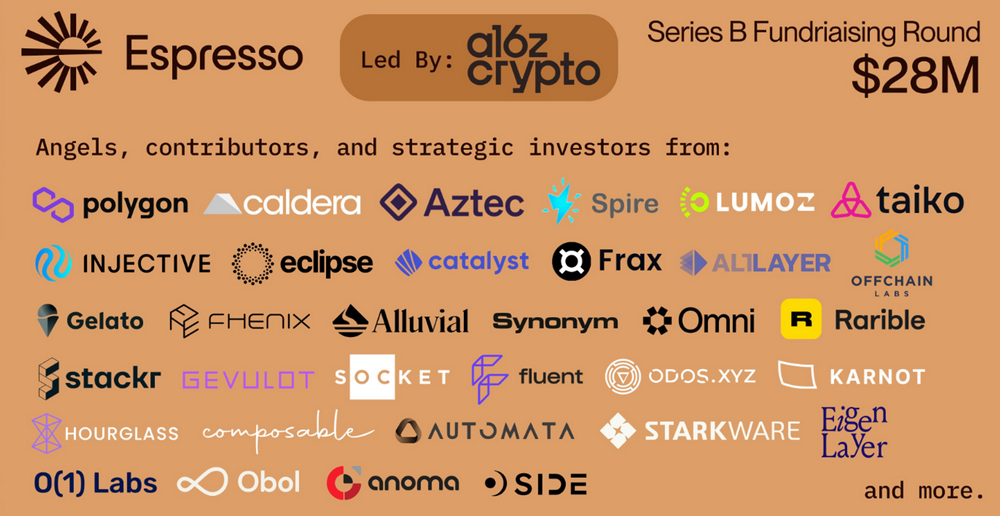
Project Summary
As an essential component of the blockchain network, transaction sequencing has become an increasingly serious issue in the Layer 2 (L2) space. The solution to the problem is a shared, decentralized sequencer. A shared sequencer essentially provides decentralized services for rollups. In addition to addressing issues such as censorship, MEV extraction, and validity, a shared sequencer also introduces cross-rollup functionality, opening up various new possibilities.
Espresso, as middleware, primarily provides shared sequencing services, bringing new unity and efficiency to the Rollup and Ethereum ecosystems through a shared sequencing market and powerful finality tools. By fair economic incentives and sequencing revenue distribution, Espresso not only addresses the current fragmentation of Rollups but also lays the foundation for future cross-chain operations and a broader ecosystem. In conclusion, it is worth keeping an eye on.
Related Links:
Official Website: https://www.espressosys.com/
Medium: https://medium.com/@espressosys
Twitter: https://twitter.com/EspressoSys
Docs: https://docs.espressosys.com/sequencer
Hackmd: https://hackmd.io/@EspressoSystems
Espresso Testnet Browser: https://be.cappuccino.testnet.espresso.network/
Related Articles: Based on Espresso: Temporary Shared Sequencing for All L2, from Aggregation to Verification
Related Articles: Binance Research Report: In-depth Analysis of Decentralized Sequencers
免责声明:本文章仅代表作者个人观点,不代表本平台的立场和观点。本文章仅供信息分享,不构成对任何人的任何投资建议。用户与作者之间的任何争议,与本平台无关。如网页中刊载的文章或图片涉及侵权,请提供相关的权利证明和身份证明发送邮件到support@aicoin.com,本平台相关工作人员将会进行核查。




